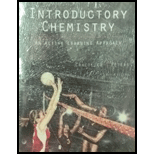
Concept explainers
A student dissolves

Aniline is used in the polyurethane manufacturing process.
Materials made from polyurethane include foams (as pictured), spandex, hardwood floor coatings, dolly wheels, and many other end products.
Interpretation:
The freezing and boiling temperature of solution on dissolving aniline in water is to be stated.
Concept introduction:
Freezing temperature of any liquid is the temperature at which vapor pressure of solid becomes equal to the vapor pressure of liquid. Addition of a solute into any other solution decreases the freezing point of solution. Boiling point is the temperature at which vapor pressure of liquid is equal to atmospheric pressure.
Answer to Problem 119E
Freezing temperature when aniline is dissolved in
Boiling temperature of solution when aniline is dissolved in
Explanation of Solution
The equation used to calculate freezing temperature of the solution is stated below.
Where,
•
•
•
•
•
The formula used to calculate the molality is stated below.
The given value of mass of aniline is
The molar mass of aniline is
The given mass of water is
Substitute the value of mass of aniline, mass of water and molar mass of aniline in equation (3) as shown below.
Calculation of freezing temperature is shown below.
The given value of
Substitute the value of
Given value of
Substitute the value of
Therefore, the
Therefore, freezing temperature of the solution is
The equation used to calculate boiling temperature of the solution is stated below.
Where,
•
•
•
•
•
Calculation of boiling temperature is shown below.
The given value of
Calculated value of
Substitute the value of
Given value of
Substitute the value of
Therefore, the
Therefore, boiling temperature of the solution is
Freezing and boiling temperature of the solution is
Want to see more full solutions like this?
Chapter 16 Solutions
Bundle: Introductory Chemistry: An Active Learning Approach, 6th + LMS Integrated for OWLv2, 4 terms (24 months) Printed Access Card
- Calculate the molality of a solution made by dissolving 115.0 g ethylene glycol, HOCH2CH2OH, in 500. mL water. The density of water at this temperature is 0.978 g/mL. Calculate the molarity of the solution.arrow_forwardAn aluminum-containing compound has the empirical formula (C2HS)2AIF. Find the molecular formula if 0.448 g of the compound dissolved in 23.46 g of benzene has a freezing point of 5.265 C.arrow_forwardSamples of each of the substances listed below are dissolved in 125 g of water. Which of the solutions has the highest boiling point? (a) 3.0 g sucrose, C12H22O11 (b) 1.0 g glycerol, C3H3(OH)3 (c) 1.0 g propylene glycol, C3H6(OH)2 (d) 2.0 g glucose, C6H12(OH)2arrow_forward
- Sodium chloride (NaCl) is commonly used to melt ice on roads during the winter. Calcium chloride (CaCl2) is sometimes used for this purpose too. Let us compare the effectiveness of equal masses of these two compounds in lowering the freezing point of water, by calculating the freezing point depression of solutions containing 200. g of each salt in 1.00 kg of water. (An advantage of CaCl2 is that it acts more quickly because it is hygroscopic, that is. it absorbs moisture from the air to give a solution and begin the process. A disadvantage is that this compound is more costly.)arrow_forwardCalcium chloride, CaCl2, has been used to melt ice from roadways. Given that the saturated solution is 32% CaCl2 by mass, estimate the freezing point.arrow_forward
 Chemistry & Chemical ReactivityChemistryISBN:9781133949640Author:John C. Kotz, Paul M. Treichel, John Townsend, David TreichelPublisher:Cengage Learning
Chemistry & Chemical ReactivityChemistryISBN:9781133949640Author:John C. Kotz, Paul M. Treichel, John Townsend, David TreichelPublisher:Cengage Learning Chemistry: The Molecular ScienceChemistryISBN:9781285199047Author:John W. Moore, Conrad L. StanitskiPublisher:Cengage Learning
Chemistry: The Molecular ScienceChemistryISBN:9781285199047Author:John W. Moore, Conrad L. StanitskiPublisher:Cengage Learning Chemistry: An Atoms First ApproachChemistryISBN:9781305079243Author:Steven S. Zumdahl, Susan A. ZumdahlPublisher:Cengage Learning
Chemistry: An Atoms First ApproachChemistryISBN:9781305079243Author:Steven S. Zumdahl, Susan A. ZumdahlPublisher:Cengage Learning
 ChemistryChemistryISBN:9781305957404Author:Steven S. Zumdahl, Susan A. Zumdahl, Donald J. DeCostePublisher:Cengage Learning
ChemistryChemistryISBN:9781305957404Author:Steven S. Zumdahl, Susan A. Zumdahl, Donald J. DeCostePublisher:Cengage Learning Chemistry: Principles and PracticeChemistryISBN:9780534420123Author:Daniel L. Reger, Scott R. Goode, David W. Ball, Edward MercerPublisher:Cengage Learning
Chemistry: Principles and PracticeChemistryISBN:9780534420123Author:Daniel L. Reger, Scott R. Goode, David W. Ball, Edward MercerPublisher:Cengage Learning





